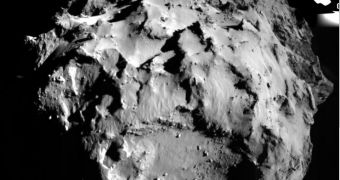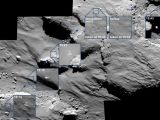A week ago, on November 12, the European Space Agency's Philae probe landed on Comet 67P/Churyumov-Gerasimenko and the whole world went nuts. These days, there is one other piece of news that is turning heads and making people jump up and down with excitement.
In a nutshell, word has it that, despite the fact that it only stayed operational for about 60 hours before it ran out of power and was forced to enter hibernation mode, the lander managed to document the presence of organic molecules on its target comet.
Why this discovery matters
As explained by scientists, all organic molecules have carbon included in their makeup. Whenever they decide to get together and cozy up to each other, these molecules birth more or less complex organic compounds.
Amino acids are among the more complex organic compounds that carbon-based organic molecules can come to form. Now, you might not know this, but the fact of the matter is that we pretty much own our existence to amino acids.
Thus, these organic compounds form proteins, which are part and parcel of our muscles, cells and all other tissues, and which control nearly all biological processes. What this means is that amino acids are basically the building blocks of life.
If the European Space Agency's Philae spacecraft is right and Comet 67P/Churyumov-Gerasimenko packs organic molecules, this could mean that, as posited by several science papers, it was comets that brought the ingredients for life to our good old Earth.
For the time being, researchers have no idea exactly what organic molecules the lander detected in the atmosphere of its target comet with the help of its COSAC (Cometary Sampling and Composition Experiment) instrument, IFL Science informs.
Besides, it is still unclear just how complex the organic molecules detected by Philae in the comet's atmosphere might be. It is understood that scientists are still interpreting data provided by the lander. Hopefully, more information will soon become available.
“COSAC was able to ‘sniff’ the atmosphere and detect the first organic molecules after landing. Analysis of the spectra and the identification of the molecules are continuing,” reads a statement issued by the DLR German Aerospace Centre, which built Philae's COSAC instrument.
Let's not jump for joy just yet
True, the European Space Agency's Philae lander successfully detected the presence of organic molecules on its target. Still, this does not mean that teeny tiny extraterrestrial life forms are hiding under the space rock's surface or that comets are indeed to thank for the emergence of life on Earth.
As mentioned, all molecules that have carbon included in their makeup count as organic. The thing is that, apart from amino acids, there are plenty other compounds that are labeled as organic but that have nothing to do with life as we know it.
Thus, methane is an organic compound. Admittedly, it is one of the simplest ever documented by science, but an organic compound nonetheless. The same is true for methanol, which, although a wee more complex than methane, is still pretty unimpressive as far as its makeup is concerned.
What this means is that, until researchers identify the exact organic molecules that Philae detected in its target comet's atmosphere, there really isn't any reason to circulate rumors about extraterrestrial life forms or anything of the sorts.

 14 DAY TRIAL //
14 DAY TRIAL // 



